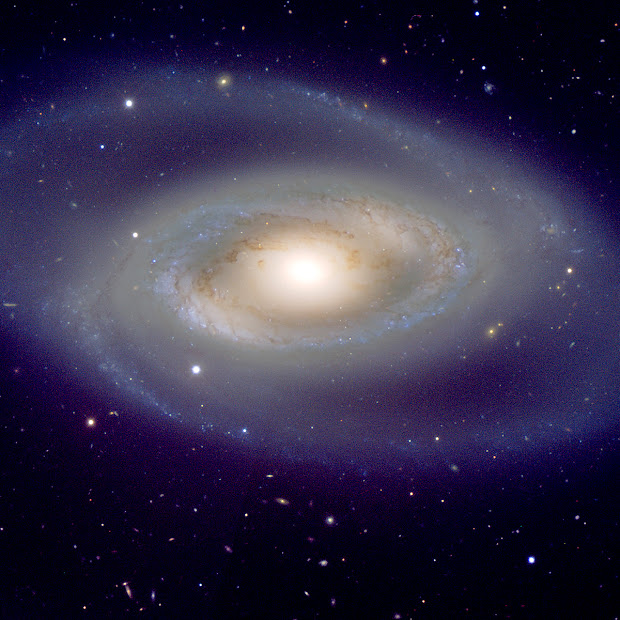Click on the image for full resolution (1.64 MB)
Beautiful colour-composite of the spiral galaxy NGC 1350 taken with FORS2 at the ESO Very Large Telescope. The image, totalling 16 minutes of observations, clearly reveals the delicate structures in this gigantic "eye" as well as many background galaxies. Resembling the shape of an eye, the galaxy exhibits a double ring structure whose blue glow reveals the presence of many young stars.
Eighty-five million years ago on small planet Earth, dinosaurs ruled, ignorant of their soon-to-come demise in the great Jurassic extinction, while mammals were still small and shy creatures. The southern Andes of Bolivia, Chile, and Argentina were not yet formed and South America was still an island continent.
Eighty-five million years ago, our Sun and its solar system was 60,000 light years away from where it now stands.
Eighty-five million years ago, in another corner of the Universe, light left the beautiful spiral galaxy NGC 1350, for a journey across the universe. Part of this light was recorded at the beginning of the year 2000 AD by ESO's Very Large Telescope, located on the 2,600m high Cerro Paranal in the Chilean Andes on planet Earth.
Astronomers classify NGC 1350 as an Sa(r) type galaxy, meaning it is a spiral with large central regions. In fact, NGC 1350 lies at the border between the broken-ring spiral type and a grand design spiral with two major outer arms. It is about 130,000 light-years across and, hence, is slightly larger than our Milky Way.
The rather faint and graceful outer arms originate at the inner main ring and can be traced for almost half a circle when they each meet the opposite arm, giving the impression of completing a second outer ring, the "eye". The arms are given a blue tint as a result of the presence of very young and massive stars. The amount of dust, seen as small fragmented dust spirals in the central part of the galaxy and producing a fine tapestry that bear resemblance with blood vessels in the eye, is also a signature of the formation of stars. The outer parts of the galaxy are so tenuous that many background galaxies can be seen shining through them, providing the observers with an awesome sense of depth. It is indeed quite remarkable to see that with a total exposure time of only 16 minutes, the VLT lets us admire such an incredible collection of island universes wandering about in the sky. The image is a mosaic of some of the most prominent galaxies found in the images. Some of these may reside as far as several billion light-years away, i.e. the light from these galaxies was emitted when the Sun and the Earth had not yet formed. NGC 1350 is located in the rather inconspicuous southern Fornax (The Furnace) constellation. Recessing from us at a speed of 1860 km/s, it is eighty-five million light-years away. It is thus most probably not a member of the Fornax cluster of galaxies, the most notable entity in the constellation, that lies about 65 million light-years away and contains the much more famous barred spiral NGC 1365. On the sky, NGC 1350 stands on the outskirts of the Fornax cluster as can be seen on this image taken with the 1m-Schmidt telescope at La Silla.
The full resolution image weighs 1.64 MB, so please be (a little) patient when downloading!
Credit: ESO










1 comment(s):
Thanks for the blog loaded with so many information. Stopping by your blog helped me to get what I was looking for. vlt gratis
Post a Comment